The Cryoboxes Market is estimated to be valued at USD 5.3 billion in 2025 and is projected to reach USD 8.9 billion by 2035, registering a compound annual growth rate (CAGR) of 5.3% over the forecast period.
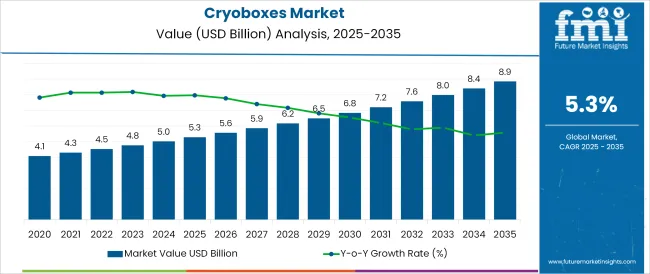
The cryoboxes market is gaining momentum amid growing demand for structured, contamination-resistant storage solutions for biological samples across research laboratories, clinical diagnostics, and pharmaceutical industries. The shift toward high-throughput testing, genetic sequencing, and precision medicine has driven the need for standardized sample storage systems that ensure traceability and thermal integrity.
Increased funding in life sciences R&D, the proliferation of biobanks, and stringent regulatory protocols for sample preservation are fueling sustained demand for cryoboxes. Additionally, advancements in box manufacturing such as autoclavable plastics, 2D barcoding, and modular design have improved handling efficiency, lab automation compatibility, and space utilization in ultra-low temperature freezers.
As healthcare systems expand capacity for cell and gene therapy, infectious disease studies, and vaccine development, cryoboxes are expected to remain essential infrastructure. The growing shift toward decentralized clinical research and personalized therapies is further expected to open new avenues for scalable, durable cryogenic storage solutions.
The market is segmented by Material Type, Capacity Range, and Application and region. By Material Type, the market is divided into Plastic, Polypropylene (PP), Polycarbonate (PC), Cardboard, and Fibreboard. In terms of Capacity Range, the market is classified into 0.5 ml to 1.5 ml, Below 0.5 ml, 1.6 ml to 2.5 ml, and Above 2.5 ml.
Based on Application, the market is segmented into Research Laboratories, Pathology Laboratories, and Diagnostic Centres. Regionally, the market is classified into North America, Latin America, Western Europe, Eastern Europe, Balkan & Baltic Countries, Russia & Belarus, Central Asia, East Asia, South Asia & Pacific, and the Middle East & Africa.
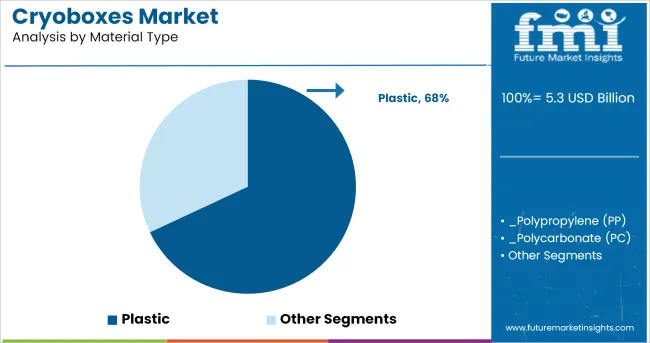
Plastic is expected to account for 68.0% of the total revenue share in the cryoboxes market by 2025, emerging as the dominant material type. This leadership is being driven by plastic’s superior durability, chemical resistance, and temperature resilience in cryogenic environments. Unlike paper-based or cardboard alternatives, plastic cryoboxes withstand repeated freeze-thaw cycles, reduce contamination risk, and offer compatibility with automation systems and barcode tracking technologies.
Manufacturers have optimized polymer blends to balance flexibility and structural integrity at temperatures as low as -196°C.
With laboratories under pressure to maximize storage density and minimize handling errors, plastic cryoboxes are being adopted as a robust, long-life solution that ensures operational continuity, traceability, and regulatory compliance in critical sample preservation workflows.
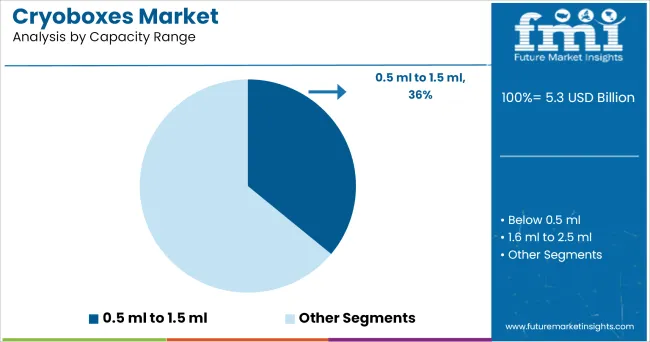
Cryoboxes with a capacity range of 0.5 ml to 1.5 ml are projected to hold 36.0% of the market revenue in 2025, making it the leading volume category. This segment’s dominance is being shaped by the standardized use of cryovials in this size range for storing cell lines, plasma, serum, and molecular samples.
These volumes are commonly used in high-throughput lab workflows and allow for optimized storage configurations within freezer racks and liquid nitrogen tanks. Cryoboxes in this category are designed to hold multiple vials securely while facilitating quick access, minimizing temperature fluctuations during handling. The compatibility of this capacity range with automated liquid handling systems and tracking software has increased its utility in large-scale biosample management.
With ongoing expansion in molecular diagnostics, infectious disease research, and biopharmaceutical R&D, the demand for cryoboxes in this mid-volume range is expected to remain high due to their balance between volume efficiency and workflow integration.
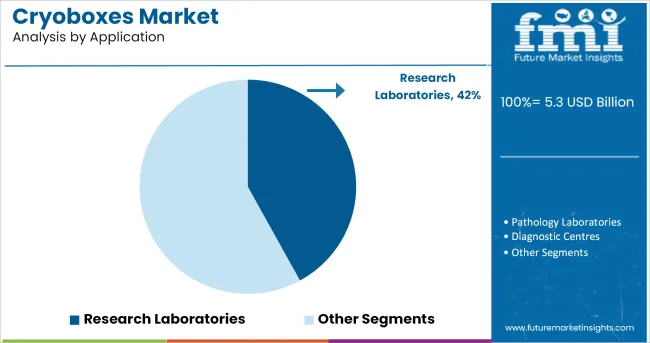
Research laboratories are expected to account for 42.0% of the cryoboxes market revenue in 2025, positioning them as the primary end-user segment. This dominance is being driven by the sector’s intensive use of biological sample storage for studies involving genomics, proteomics, and cell biology. Cryoboxes are critical in maintaining sample integrity during long-term storage, which is essential for reproducible research and data validation.
The proliferation of government and private funding in biomedical research, particularly in areas such as cancer, immunology, and infectious diseases, is accelerating cryobox adoption. Additionally, research labs often operate under Good Laboratory Practice (GLP) conditions, requiring standardized, traceable, and contamination-free storage systems-capabilities that cryoboxes are specifically designed to deliver.
Integration with sample tracking software and compatibility with lab robotics has also made cryoboxes a preferred storage solution for scaling research infrastructure. As precision medicine and translational research continue to expand, the role of cryoboxes in research environments is expected to grow significantly.
Cryoboxes are designed to store samples in cryogenic vials and tubes in extreme temperatures. Cryoboxes can be customized as per customer requirements for capacity. Printed location grids, hinged lid and moisture-repellent coating are few prominent features of cryoboxes.
The ongoing research on improved vaccine development, production of better anti-viral drugs and immunity-boosting shots is fueling the market growth.
The development of ultra-low freezers or ULTs could be reckoned as a revolution in the refrigeration industry. Production of ultra-low freezers is expected to push the development of compatible cryoboxes to store vaccine samples.
An article published in BioMed Central Ltd. on 24th March 2024, contributes to deeper insights into understanding cryopreservation and how its usage in almost every field is set to affect the future of medicine and drug discovery in coming years. It is expected to not only uplift the market for cryoboxes but also assist in product development.
The biopharmaceutical industry lies at the core of the pharmaceutical industry with a potential of expeditious amplification in the coming years. The innovation-led sector highly comprises disruptive technology, digitization and a holistic approach for the treatment of incurable diseases.
The scope of development of the biopharmaceutical industry is reshaping the dynamics of the cryoboxes market. Cryoboxes applications are projected to intensify with escalating biopharmaceutical industry. Cryovials could be used for the storage of drugs for cancer, HIV and Alzheimer's disease.
According to a report published by the Pharmaceutical Research and Manufacturers of America (PhRMA), in 2020 biopharmaceutical industry in the USA accounted for 3.2% of the total country’s GDP, with a value of USD 625 billion.
Downward cost pressure for product affordability in the pharmaceutical and healthcare sector is expected to hamper the demand for cryoboxes. The complexity of continuous product development and manufacture of superior quality cryoboxes can raise its selling prices in the market, which can affect the supply of the product.
Material like polypropylene has a shorter life span and takes 20-30 years to decompose, which can result in the accumulation of waste. Replacing polypropylene with cardboard and fiberboard increases the product prices and doesn’t exactly provide the same efficiency as the material. This factor can restrict the market growth of cryoboxes.
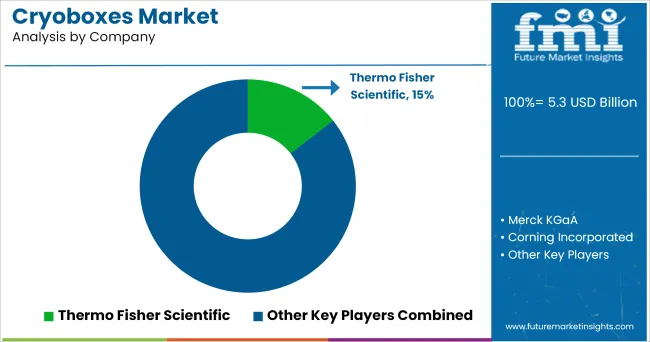
Cryoboxes market is highly competitive with the presence of large global and local players. Key players in the market are providing customization in case of sizes to the customers. Some players are also innovating cryobox lids to seize some market share. Overall innovation in material, size and appearance is expected to remodel the market shares.
Denmark based player Capp ApS is providing eco-friendly cardboard cryoboxes, which not only repels moisture but also circumvents mild chemical spills.
The biodegradability and recyclability of material are playing a vital role in changing the dynamics of the cryoboxes market. Environmental-friendly material innovations are the key to success in the cryoboxes market. Cardboard and fibreboard cryoboxes are expected to witness growth during the forecast period.
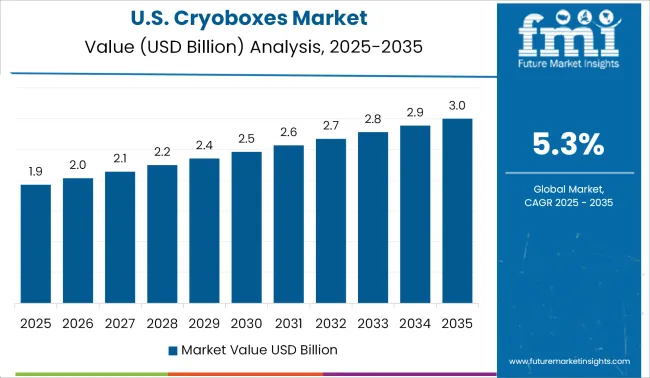
The United States is known to have the least market barriers for the entrance of a new market player in the pharmaceutical market. It also contains the most supportive business environment for the commercialization and development of pharmaceutical equipment and drugs. The USA is considered to be a grossing market for cryoboxes, it is expected to attract a majority of investments and is likely to observe the entrance of new manufacturers during the forecast period.
The global cryoboxes market is estimated to be valued at USD 5.3 billion in 2025.
The market size for the cryoboxes market is projected to reach USD 8.9 billion by 2035.
The cryoboxes market is expected to grow at a 5.3% CAGR between 2025 and 2035.
The key product types in cryoboxes market are plastic, polypropylene (pp), polycarbonate (pc), cardboard and fibreboard.
In terms of capacity range, 0.5 ml to 1.5 ml segment to command 36.0% share in the cryoboxes market in 2025.






Full Research Suite comprises of:
Market outlook & trends analysis
Interviews & case studies
Strategic recommendations
Vendor profiles & capabilities analysis
5-year forecasts
8 regions and 60+ country-level data splits
Market segment data splits
12 months of continuous data updates
DELIVERED AS:
PDF EXCEL ONLINE
Market Share Breakdown of Cryoboxes Manufacturers

Thank you!
You will receive an email from our Business Development Manager. Please be sure to check your SPAM/JUNK folder too.
Chat With
MaRIA